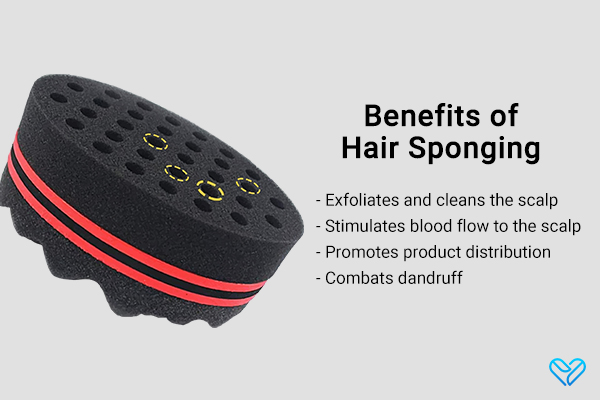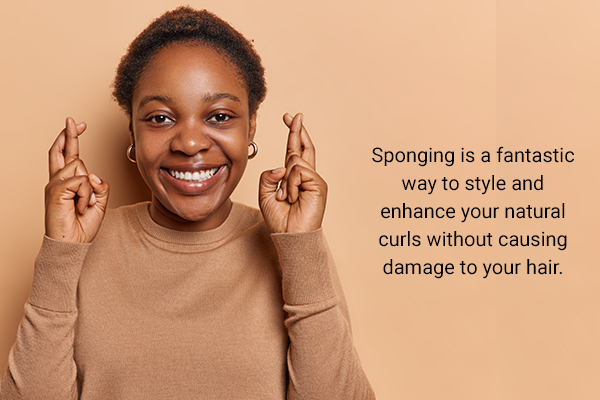In this article:
For years now, people have been using different techniques to enhance the health and appearance of their hair, one of them is sponging, which involves the use of a sponge to massage the scalp to stimulate hair growth. (1)

According to experts, including dermatologists and health professionals, sponging the hair may not directly impact hair growth. Using a hair sponge can deliver benefits such as scalp exfoliation and enhanced blood flow, which, in some ways, may influence the rate of hair growth.
Nonetheless, it’s critical to bring up that the efficacy of this technique is not scientifically verified, and personal experiences may differ.
This article will examine the subject of sponging hair and its effect on hair growth.
Sponging Hair and Its Impact on Hair Growth
Sponging hair involves massaging the scalp with a wet sponge or brush. The idea behind this practice is that it can stimulate the scalp and improve blood circulation, which may, in turn, promote hair growth, (1) but there is no scientific evidence to support the claim.
Sponging hair can have some benefits for the scalp and hair as the massaging technique can be helpful in stimulating the scalp and improving blood circulation. It can also aid in distributing the natural oils produced by the scalp, which can help to keep the hair hydrated and healthy.
These can be the reasons behind its effect on hair growth, but it is just one piece of the puzzle and is not the key to solving all your hair problems. This is because hair growth is controlled by multiple factors such as genes, hormonal interactions, and diet.
Also, it’s important to be conscious of the fact that vigorous or aggressive sponging can contribute to hair breakage.
Benefits of Hair Sponging
Here are some benefits of hair sponging.

1. Exfoliates and cleans the scalp
An unhealthy scalp may harm hair growth. (2) A hair sponge is a soft, porous material that works by gently exfoliating the scalp, which helps to remove dead cells, extra oil, and any buildup that can clog the hair follicles and impede hair growth.
By maintaining a clean scalp and removing scalp buildup, the hair follicles can function well, letting the hair grow healthily. (2)
2. Stimulates blood flow to the scalp
When you massage your scalp with a hair sponge, you improve the blood flow to the area, which in turn may stimulate the hair follicles and promote hair growth. (1)
3. Promotes product distribution
Using a hair sponge helps spread hair products all around the scalp and hair. This ensures that useful ingredients, such as oils or conditioners, reach the entire scalp and hair ends, providing the required benefits for healthy hair growth.
4. Combats dandruff
Dandruff contributes to hair fall and reduced hair growth. The mild exfoliating activity of a hair sponge helps expel dandruff flakes, lessening the buildup of dandruff and building a better scalp environment for optimum hair growth. (2)
How to Sponge the Hair?
Here are the steps for sponging the hair:
- Wet your hair thoroughly with warm water.
- Apply a tiny quantity of shampoo on your scalp and massage it carefully using your fingers. Ensure that you use the shampoo throughout all the strands.
- Wash the shampoo away with water.
- Squeeze any extra water from your strands, so that it is damp but not dripping wet.
- Take a soft sponge or brush and carefully massage your scalp in circular motions, covering the entire scalp.
- Continue to massage your scalp, concentrating on regions that are extremely flaky.
- Wash your hair with water to take out the remaining shampoo.
- Dry your strands using a towel, being careful not to rub vigorously or tug on your hair.
Will Sponging Help in Styling My Hair?

One cool technique to add some shine to your naturally curly hair is to use a hair sponge. This handy tool has a unique texture with tons of tiny pits on the surface.
By rubbing the sponge like you’re drawing circles on your hair, you can build beautiful spirals or coils.
Sponging is a fantastic way to style and enhance your natural curls without causing damage to your hair. To get started, you’ll need a hair sponge and optional hair products such as leave-in conditioners, curl creams, or gels.
Just use the product on your hair and start sponging away!
So, if you’re looking for an efficient method to style your curly hair and make it look fabulous, give hair sponging a try. Just remember to use the hair sponge gently and with care, so you don’t cause any damage to your beautiful locks.
What to Use on the Hair Before Sponging It?
To prepare your hair for sponging, you need to dampen it. Based on the condition of your hair, you may not require any additional products.
However, some people like to use leave-in conditioners, curl creams, or gels before sponging their hair.
The key is to ensure your hair is slightly wet, so the hair sponge can work its magic on your scalp.
Can Sponging Damage Hair?
If you’re worried about damaging your hair with a sponge, don’t be! The truth is a hair sponge is a safe and useful tool when used correctly.
Nevertheless, it’s significant to point out that incorrect usage can cause hair breakage. So, to prevent any damage to your beautiful hair, there are a few things you should keep in mind:
- Never use the sponge on dry hair. Make sure your hair is dampened first, so it’s easier to work with.
- You’ll also want to moisturize and detangle your hair before sponging.
- Be gentle when using the sponge on your hair. Avoid being too aggressive and rubbing too hard, as this can cause breakage.
Most-Asked Questions About Hair Sponging
Can sponging hair cause hair loss?

No, sponging hair should not cause hair loss, provided it is done gently and without causing any damage to the hair or scalp.
How frequently should I sponge my hair?
There is no set frequency for sponging hair. You can do it twice a week or as you like, provided it is not causing any damage to the hair or scalp.
Is there scientific proof that sponging hair can promote hair growth?
No, there is no scientific proof that supports that sponging hair can promote hair growth. However, sponging hair can have some benefits for the scalp and hair, such as exfoliating the scalp and distributing natural oils.
Final Word
While there is no scientific evidence to support the claim that sponging hair can promote hair growth, it can have some benefits for the scalp and hair, such as exfoliating the scalp and distributing natural oils.
However, there are proven ways to promote hair growth, including a healthy diet, taking supplements, and stress reduction. If you are concerned about hair loss or hair thinning, it is best to speak to a dermatologist or hair specialist who can provide you with personalized advice and treatment options.
- Was this article helpful?
- YES, THANKS!NOT REALLY


